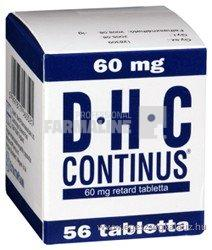
DHC CONTINUS 60mg Price
Active Substance: Dihydrocodeine tartrate.
Overview
Welcome to Dwaey, specifically on DHC CONTINUS 60mg page.
This medicine contains an important and useful components, as it consists of
Dihydrocodeine tartrateis available in the market in concentration
Name
Dihydrocodeine tartrate
Precaution
<p>Dihydrocodeine tartrate should be used with caution in patients with respiratory disorders such as asthma, COPD, or cor pulmonale. It should also be used cautiously in individuals with a history of drug abuse, head injury, increased intracranial pressure, or hepatic or renal impairment. Long-term use may lead to dependence or tolerance. Alcohol use should be avoided due to the risk of CNS depression. Monitor patients for signs of respiratory depression and sedation, especially when initiating therapy or increasing dosage.</p>
Indication
<p>Dihydrocodeine tartrate is primarily indicated for the relief of moderate to moderately severe pain. It may also be used in combination preparations for the treatment of persistent cough and dyspnea in certain chronic pulmonary conditions, though its use for these indications has become less common due to potential risks and availability of safer alternatives.</p>
Contra indication
<p>This medication is contraindicated in patients with known hypersensitivity to dihydrocodeine or other opioids. It is also contraindicated in individuals with severe respiratory depression, acute asthma attacks, or known or suspected gastrointestinal obstruction, including paralytic ileus. Use is not recommended in patients with acute alcoholism, head injuries, or conditions that increase intracranial pressure.</p>
Side Effect
<p>Common side effects include drowsiness, dizziness, constipation, nausea, and vomiting. Less commonly, patients may experience dry mouth, sweating, pruritus, or urinary retention. Serious adverse effects can include respiratory depression, hypotension, bradycardia, and dependence with long-term use. Allergic reactions such as rash or anaphylaxis are rare but possible.</p>
Pregnancy Category ID
Information not available
Mode of Action
<p>Dihydrocodeine is a semi-synthetic opioid analgesic that exerts its action by binding to μ-opioid receptors in the central nervous system. This binding inhibits the transmission of pain signals and alters the perception and emotional response to pain. It also suppresses the cough reflex and can produce sedation through central nervous system depression.</p>
Interaction
<p>Concurrent use with CNS depressants such as benzodiazepines, alcohol, antihistamines, and other opioids can potentiate sedation and respiratory depression. CYP2D6 inhibitors (e.g., fluoxetine, paroxetine) may affect the metabolism of dihydrocodeine, potentially altering its efficacy and safety profile. Caution should be taken with serotonergic drugs due to a possible increased risk of serotonin syndrome. Avoid MAO inhibitors within 14 days of therapy.</p>
Pregnancy Category Note
<p>Dihydrocodeine is classified as Pregnancy Category C. Animal studies have shown adverse fetal effects, and there are no adequate, well-controlled studies in pregnant women. Use during pregnancy should be avoided unless the potential benefits justify the potential risk to the fetus. Neonatal withdrawal syndrome and respiratory depression may occur if used long-term during pregnancy or labor.</p>
Adult Dose
<p>The typical adult oral dose for pain relief is 30 mg every 4 to 6 hours as needed. Maximum dose and frequency should be determined based on the patient's response, tolerance, and clinical condition. Extended-release formulations should be dosed according to manufacturer recommendations, generally every 12 hours.</p>
Child Dose
<p>Dihydrocodeine is not recommended for use in children under 12 years of age due to the risk of respiratory depression. For children aged 12 and older, dosing should be carefully considered and supervised by a healthcare provider, generally starting with 0.5 mg/kg per dose every 4 to 6 hours, not exceeding adult doses.</p>
Renal Dose
<p>In patients with renal impairment, clearance of dihydrocodeine may be reduced, leading to drug accumulation. Dosage adjustments may be necessary, and close monitoring for signs of toxicity (e.g., sedation, respiratory depression) is advised. Use with caution and at the lowest effective dose.</p>
Administration
<p>Dihydrocodeine tartrate is administered orally and should be taken with or without food. Tablets should be swallowed whole with a glass of water. Extended-release forms must not be crushed or chewed. Patients should be instructed to adhere strictly to prescribed dosing and not exceed recommended amounts to minimize the risk of overdose and dependence.</p>
